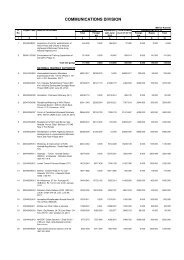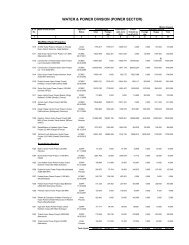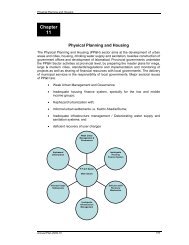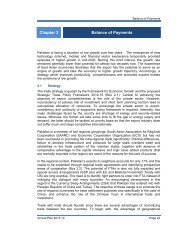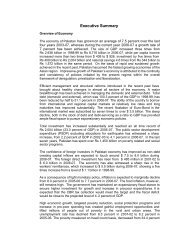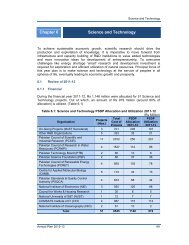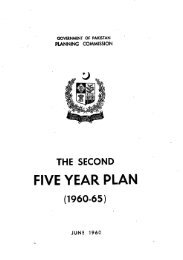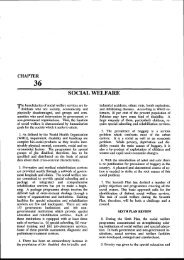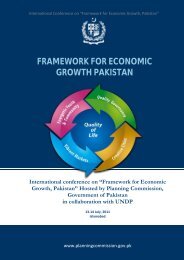Manual for Development Projects - Planning Commission
Manual for Development Projects - Planning Commission
Manual for Development Projects - Planning Commission
You also want an ePaper? Increase the reach of your titles
YUMPU automatically turns print PDFs into web optimized ePapers that Google loves.
Chapter 5<br />
and benefits would lead to under - estimation of costs or over-estimation of benefits or vice versa. The<br />
identification of secondary costs and benefits is a difficult task. For example, most of the benefits from an<br />
expanded irrigation project may be offset by a fall in fish production and reduce income <strong>for</strong> thousands of<br />
fishermen. Increased benefits due to the construction of a new highway may be equally matched by a<br />
reduction in the income of the railways due to decrease in passengers/goods. An important technique which<br />
is followed <strong>for</strong> correct quantification of costs and benefits is "with and without project" comparison of costs<br />
and benefits. Project analysis tries to identify and value costs and benefits that arise with the proposed<br />
project and to compare them with the situation as it would be without the project. The difference is the<br />
incremental net benefits arising from the project investment. This approach is not the same as comparing<br />
the situation "be<strong>for</strong>e" and "after" the project. The "be<strong>for</strong>e" and "after" comparison fails to account <strong>for</strong><br />
changes in production over the life of the project that would occur without the project and thus leads to an<br />
erroneous statement of benefits attributable to the project investment. A change in output can also occur<br />
without the project if production would actually fall in the absence of new investment. In some cases, an<br />
investment to avoid a loss might also lead to an increase in production so that the total benefits would arise<br />
partly from the loss avoided and partly from increased production. Here are some special items which must<br />
carefully be handled while identifying and quantifying costs and benefits <strong>for</strong> financial and economic<br />
analyses:<br />
i) Direct Transfer Payments<br />
Some entries in financial accounts really represent shifts in claims of goods and services from one<br />
entity in the society to another and do not reflect changes in the national income. The following<br />
four kinds of transfer payments are important which are not included in economic analysis:<br />
(a) Taxes (Direct and Indirect)<br />
When a farmer pays a tax, his net benefit is reduced but it does not reduce national<br />
income. It is a cost to the farmer and is not a cost from the stand-point of society as a<br />
whole. Thus, unlike financial analysis, in economic analysis, we would not treat the<br />
payment of taxes as a cost in project accounts. However, some taxes called user taxes<br />
are exempted from this rule. Governments often include payments <strong>for</strong> road<br />
improvements, water or power supply charges in property taxes and this element of<br />
property tax does represent a real cost to society. Highway and bridges tolls, if<br />
accurately set, also may be users taxes and represent real cost. But taxes on gasoline<br />
and petrol do not represent users taxes.<br />
(b) Subsidies<br />
Subsidies are simply direct transfer payments, that flow in the opposite direction from<br />
taxes. If a farmer is able to purchase fertilizer at a subsidized price, that will reduce his<br />
costs and thereby increase his net benefit. But fertilizer used by the farmer is cost to<br />
the economy and in economic analysis must enter the full cost of fertilizer. Another<br />
<strong>for</strong>m of subsidy is that which lowers the selling price of inputs below what otherwise<br />
would be their market price. Market price may be maintained at a level higher than it<br />
otherwise would be by, say, levying an import duty on competing imports or <strong>for</strong>bidding<br />
competing imports altogether. The difference between the higher controlled price, set<br />
by such measures, and lower price <strong>for</strong> competing imports, that would prevail without<br />
such measures, does represent such indirect subsidy.<br />
(c) Credit Transactions<br />
Credit transactions are the other major <strong>for</strong>m of direct transfer payment. Loan to a<br />
farmer, <strong>for</strong> example, does not reduce the national income. It merely transfers the<br />
control over resources from the lender to borrower. Same is the case when the farmer<br />
repays the loan (interest + principal).<br />
(d) Interest<br />
http://hd2/pc/popup/ch5_p.html<br />
Page 5 of 24<br />
In determining the gross cost-stream <strong>for</strong> calculating discounted measures of project<br />
worth, we do not include interest as a cost both in economic and financial analysis.<br />
Expressing it in another way, we do not deduct interest from the benefit-stream on the<br />
capital supplied by the entity <strong>for</strong> which we are doing the analysis, because in effect the<br />
9/23/2010




